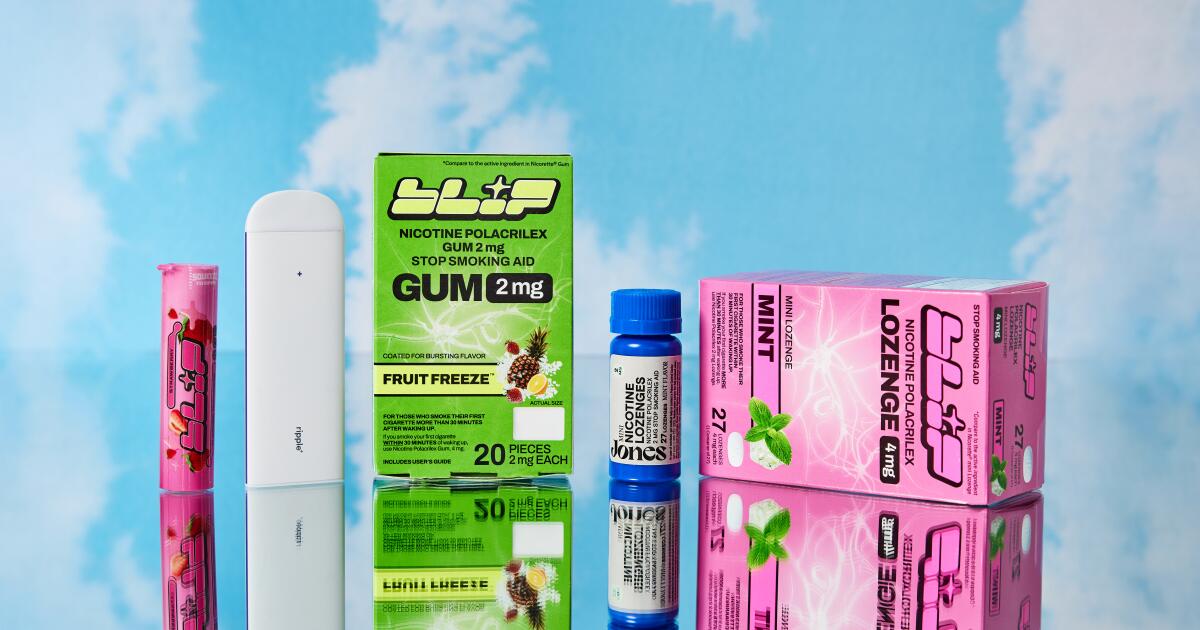Lifestyle
Millions of pounds of meat are being recalled. Here's what to look for in your fridge

A sampling of some of the hundreds of ready-to-eat products affected by the BrucePac recall, according to the USDA.
U.S. Department of Agriculture
hide caption
toggle caption
U.S. Department of Agriculture
Public health authorities are urging Americans to check their fridges and freezers after recalling more than 11 million pounds of ready-to-eat meat and poultry items over possible listeria contamination.
The Oklahoma-based company BrucePac, which sells pre-cooked proteins, is recalling 11,765,285 pounds of meat and poultry that it shipped to grocery stores, restaurants, schools and other institutions nationwide, according to the U.S. Department of Agriculture’s Food Safety and Inspection Service (FSIS).
The FSIS says it detected listeria during routine testing of finished products containing BrucePac poultry, which a subsequent investigation confirmed as the source.

The bacteria can cause a serious infection that is especially dangerous for people who are pregnant, over 65 or have weakened immune systems. There have been no confirmed reports of adverse reactions linked to the products, it adds.
Authorities first announced the recall last week, but have since expanded it to cover more than one million additional pounds of meat and poultry products. That amounts to hundreds of items from dozens of popular brands, sold at over a dozen grocery chains across the country.
The USDA also confirmed this week that the products have been distributed to schools and says it will post a school distribution list on its website once one is available.
The recalled products include salads, wraps, pasta bowls, burritos, enchiladas and many other ready-made frozen and family meals, and come from brands including Fresh Express, Rao’s, Boston Market, Atkins, Dole, ReadyMeals, Taylor Farms, Home Chef and Signature Select.
The stores that carry them include Aldi, Amazon Fresh, Giant Eagle, H-E-B, Kroger, Meijer, Publix, Target, Trader Joe’s, Walmart, Wegmans and 7-Eleven.

The affected goods were produced between May 31 and Oct, 8 and bear the establishment numbers “51205” or “P-51205” either inside or underneath the USDA mark of inspection. But BrucePac cautioned that the number is only on packages it ships directly to customers, not retail packages.
“Because we sell to other companies who resell, repackage, or use our products as ingredients in other foods, we do not have a list of retail products that contain our recalled items,” the company said in a statement, adding that the best way for people to identify contaminated products is through the USDA website or by calling the company or retailer from which they got the package.
The USDA is maintaining a list of recalled products — which is 345 pages long as of Wednesday — and urging people to use the search function to look up individual products, stores and brands and throw away any that they may have at home.
Authorities say they are also “concerned that some product may be available for use in restaurants, institutions, schools and other establishments” and are urging them to throw the goods out immediately.
For its part, BrucePac says it is working closely with the USDA to notify consumers, contact the food companies and distributors affected and ensure “all necessary actions are taken to ensure a safe food supply.”
“We will not resume production until we are confident the issue has been resolved,” it added.
What to do if you’re worried
The USDA is urging people to toss any affected products and monitor its website for more information as it becomes available.
It says consumers with food safety questions can call the toll-free USDA Meat and Poultry Hotline at 888-674-6854 or email MPHotline@usda.gov, and can report complaints about any meat, poultry or egg products online.
Anyone concerned about illness should contact their healthcare provider, the department adds.

Eating food contaminated with listeria can cause listeriosis, an invasive infection that spreads beyond the gastrointestinal tract and must be treated with antibiotics.
The Centers for Disease Control and Prevention says listeria infection is the third leading cause of death from foodborne illnesses in the U.S., estimating that 1,600 people are infected and 260 people die from it each year.
The infection can be fatal in older adults and people with weakened immune systems, and can cause miscarriages, stillbirths, premature delivery in pregnant women as well as life-threatening infections in their newborns.

Symptoms of listeriosis include fever, chills, muscle aches, nausea, diarrhea, stiff neck, loss of balance and convulsions. Symptoms could begin within a few days of eating contaminated food in some cases, but in others could take 30 days or more to show up, according to the Mayo Clinic.
The USDA says anyone in the higher-risk categories who experiences flu-like symptoms within two months after eating contaminated food should seek medical care and tell their health care provider about the food.
Listeria concerns have been responsible for other recalls in recent months, including an outbreak linked to Boar’s Head deli meat that resulted in 59 hospitalizations and 10 deaths across 19 states this summer. The USDA has since opened an internal investigation into its handling of prior reports of safety violations at Boar’s Head’s Virginia plant.
NPR’s Chandelis Duster contributed reporting.

Lifestyle
What Matters Most to World Markets in a Tight US Election Race

Lifestyle
See How Hair Took Center Stage at Fashion Week

With all the attention paid to clothes seen at fashion weeks, it can be easy to overlook the handiwork of hairstylists and barbers. But as hair becomes as integral to personal style as clothing, the diversity of eye-catching hairstyles has grown to rival the breadth of apparel and accessories worn by models and people in the street.
The styles at recent shows have been seen before, but some served as a barometer of how far this golden age for hair has come. Futuristic, sculpted looks, for instance, are no longer outliers but part of the tapestry of fashion weeks in New York, London, Milan and Paris. What set many styles apart was the precision seemingly given to cuts, colors and styling techniques.
Some people even managed to make long blond hair — one of the most traditional (and basic) conventions of beauty — look fresh by adding volume, texture or both. And if long blond hair can be made to look exciting, just imagine the lengths achieved by others with big curls, loose waves and closer crops.
Lifestyle
Gen Z wants to quit vaping. Can a new wave of trendy products help?

When model Josephine Lee, known online as Princess Gollum, arrived in Studio City for a skincare brand photo shoot in November 2021, she had all her signature accessories in tow. An eerie-chic partially shaved head, spooky colored contacts and a green, matcha-flavored vape in the grasp of her long fingernails.
Despite a recent health scare and an order from her doctor to stop vaping, everytime the camera was down, the candy colored device was back in her mouth. On set, she confided in Julie Schott about her desire to quit. Los Angeles-based Schott, who is the owner of Starface, the wildly popular pimple patch brand Lee was shooting for, immediately felt her business brain buzzing. She’s made her career destigmatizing clinical products like acne treatments to the morning after pill through millennial and Gen-Z friendly marketing. By the end of the photo shoot, Schott and Lee were inspired to reinvigorate the nicotine replacement therapy (NRT) industry.
Others have followed suit. A rush of aesthetically minded products with Instagram-approved branding have flooded the NRT market over the last few years, including companies with nicotine replacement products like BLIP and Jones and nicotine-free devices like Luvv and Ripple. They have a new audience in mind: vapers.
In 2021, 4.5% percent of all Americans over 18 used vapes, according to the Centers for Disease Control and Prevention, while 10% percent of high schoolers vaped, according to a 2023 study. As younger nicotine consumers confront the health downsides of their habits, these companies are advertising photogenic solutions that dress up versions of an old formula by catering to both young vapers’ consumption habits and style.
Lozenges, gum, flavored toothpicks and nicotine-free vapes aimed at helping a younger generation quit vaping.
(Jessica Miller/For The Times)
When Nicorette was invented in Sweden in the late 1970s, it was the first NRT available to smokers who wanted to quit. As popularity increased, their product range expanded from chewing gum to include the five other antismoking products approved by the Food and Drug Administration: lozenges, patches, inhalers and nasal sprays. Look on any drug store shelf today and you’ll find a handful of brands in the space selling five products with nearly the same ingredients, but with different names and branding. But while NRTs have helped millions of cigarette smokers cut down on the habit, until recently, they’ve looked drab and medicinal, something Schott and Lee believes intimidates younger generations of nicotine users from giving them a shot.
In August 2023, nearly two years after Schott and Lee’s connection at the photo shoot, BLIP was born. It set itself apart in the market with colorful packaging, futuristic fonts and Instagram and TikTok content featuring Princess Gollum and her internet famous fashion friends. Their tagline? “Die another way.”
“No one in this space was trying to do anything new,” said Lee, who alongside the brand’s third L.A.-based co-founder Alyson Lord, used BLIP lozenges and gum to successfully quit.
“When I spoke to my friends who wanted to quit vaping, the general consensus was that it was impossible. The ones who quit went back to cigarettes. I didn’t understand how to use the products that were out there [to quit],” said Lee.
Because traditional NRT products largely cater to consumers who are addicted to smoking cigarettes rather than vaping, it can be hard for vapers to know how to use them. Per the FDA’s regulations of NRT products, which has not yet approved any methods for specifically quitting vaping, dosing instructions on both legacy products like Nicorette and new brands must be based on how many cigarettes a user smokes per day. These instructions can make it harder for vape users — who, at best, may know how often they buy a new vape or cartridge, but not how often they pick up the device — to use NRTs to quit without additional information. (Reached for comment, FDA spokesperson Cherie Duvall-Jones said the government agency “recognizes that vaping is a common method of nicotine use,” and welcomes groups to engage with it to develop products that will help people quit the habit.)
“No one in this space was trying to do anything new.”
— Josephine Lee, model and co-founder of BLIP
BLIP’s lozenges and gum (both $17.99 for a 20-pack) contain the same FDA-regulated ingredients as legacy NRT products. The difference lies in the slick branding and educational language that targets vape users specifically. While the company’s packaging follows strict FDA guidelines by advising usage based on the number of cigarettes a consumer smokes per day, its online marketing efforts provide additional information geared toward vapers on how to best use NRTs to suit their needs. A free quiz on the BLIP website, for example, suggests treatment plans based on how frequently a customer vapes, and whether they prefer disposable vapes (like Elf Bars) or pod-based vapes (like JUUL).
The tweak in messaging is working. In BLIP’s first year, across 79 CVS stores, 59% of BLIP buyers were purchasing NRT products for the first time. According to Schott, last month, the brand expanded its availability to 3,500 retail CVS stores. Schott said she hopes to get BLIP products where people are vaping or struggling to resist, like airports, nightclubs and, most recently, New York Fashion Week.
The brand’s sleeper hit? Toothpicks with fruity vape-like flavors like strawberry and blue raspberry that contain no NRT ingredients at all ($17.99 for a pack of three flavors). The brand recommends using them in tandem with NRTs to satiate the hand-to-mouth habit of vaping. After Doja Cat was spotted with one at this year’s Grammys, the brand says they saw a 1,200% sales boost.

Josephine Lee partnered with Julie Schott to create BLIP, a company that makes colorful, edgy nicotine replacement therapy products.
(Jason Armond/Los Angeles Times)
Timothy Flach, a 33-year-old hairstylist in Hollywood used BLIP to quit vaping. Flach smoked a pack of cigarettes a day for 15 years before switching to vaping all day. He had never tried quitting nicotine entirely, but he knew he didn’t want to carry a vape around his own wedding this past March. Using BLIP gum and lozenges, he successfully quit a year before the big day.
“BLIP tastes better than the other [NRT brand] gums, which I used when I would run out of BLIP and needed support,” he said. “It’s very eye-catching and cool. I like seeing people that I have admired for years like Cobra Snake and Doja Cat using it, too.”
Los Angeles model and actor Aaliyah Ei, 27, quit smoking in 2020 but quickly turned to vaping. Schott said she hopes to get BLIP products everywhere people are vaping or struggling to resist, like airports, nightclubs and, most recently, New York Fashion Week.
“BLIP was the first to educate me that I was using the gum wrong,” said Ei. She learned about the ‘park’ method from BLIP’s instructions, in which one ‘parks’ the chewing gum in their gums to ensure the ingredients absorb fully. She brings BLIP toothpicks with her on nights out.
“They’re a huge vibe and when I’m out, people are so interested in them,” she said.
While BLIP is bright, flashy and associated with nightlife, Jones is its understated, aspirational GOOP-like foil. Jones was founded in November 2023 by Los Angeles-born childhood friends Hilary Dubin and Caroline Huber. The two twenty-somethings, now based in New York City, developed vaping addictions while working in tech and politics, respectively. Their brand sells only one product: NRT lozenges — often referred to by the brand as mints — that come in an embossed, mint green tin ($69 for 81).

Jones founders Caroline Huber, left, and Hilary Dubin.
(Quit with Jones)
Like BLIP, Jones lozenges use the same FDA-approved ingredients as Nicorette, but hope to reach consumers who are looking for a more subtle, feel-good solution to their addiction. The brand’s packaging also offers usage instructions based on cigarette use in accordance with FDA guidelines. But they’re also operating in a vape-forward gray area, tailoring their social media posts to focus on lesser-known side effects of vaping, like reduced sense of taste and smell. The company also has a free app that uses AI to create custom quit plans for users and provide support from a community of “quitters” — a word used heavily in their branding.
“Our target is the health-conscious customer,” said Dubin. “A lot of the other companies in this space are leaning into this kind of negative or cheeky messaging or their brand is a bit intimidating.”
Both founders used Nicorette when trying to quit, but had the same issues understanding the dosing instructions and felt embarrassed carrying the product with them.
“It felt so backwards,” Dubin said. “I would vape openly or I’d have a cigarette at a party, but I would hide my Nicorette in my bag because it was in this ugly pill bottle. So for Jones, the tin was No. 1.”
“I would hide my Nicorette in my bag because it was in this ugly pill bottle.”
— Hilary Dubin, co-founder of Jones

Jones mini nicotine lozenges, which the brand refers to as “mints,” come with a discrete tin.
(Jessica Miller/For The Times)
This was a selling point for 30-year-old interior designer Kelly Maguire in Brooklyn. Maguire used Jones mints in tandem with their app and an audio book about quitting to successfully give up her years-long vaping habit.
“I chose Jones because the branding was chic and pretty non-descriptive,” Maguire said “I didn’t want to have to talk about the fact I was quitting and other NRT products were pretty obvious.”
Since launching, the brand has received 12,000 orders on its website and its app has been downloaded 16,000 times, according to Dubin, the product is available in two New York City boutiques and has hosted pop up events with Gen-Z editorial platform Byline. They hope to expand to more online and in person retailers.
Meanwhile, some vape users are also turning to nicotine-free vapes from brands like Luvv and Ripple to reduce or quit vaping while satiating their oral fixation and love for fruity flavors. Both products attempt to tap into wellness-centric branding. Luvv advertises “vitamins and naturally occurring compounds” in a berry mint flavored vape with B-12 and a citrus flavored vape infused with caffeine. Ripple calls their vapes “aromatic diffusers” and notes they are vegan and cruelty free.
While the FDA has yet to approve any methods for quitting vaping — companies like BLIP and Jones have succeeded in competing with vaping on one crucial aspect: a certain cool factor. This generation of vapers wants quitting to be as photogenic, chic and flavorful as vaping itself. And in the thick of a larger self-care and wellness movement, these new NRT products are just one more stylish supporting accessory in conversations (and TikToks) around one’s self-improvement journey.
-

 Entertainment7 days ago
Entertainment7 days agoHold my beer can: Museum says a worker thought unique art installation was trash
-

 Entertainment1 week ago
Entertainment1 week ago'The Office' star Jenna Fischer reveals private breast cancer battle: 'I am cancer free'
-
/cdn.vox-cdn.com/uploads/chorus_asset/file/25673932/462754179_560996103109958_6880455562272353471_n.jpg)
/cdn.vox-cdn.com/uploads/chorus_asset/file/25673932/462754179_560996103109958_6880455562272353471_n.jpg) Technology4 days ago
Technology4 days agoMeta suggests AI Northern Lights pics are as good as the real thing
-

 Technology6 days ago
Technology6 days agoScammers exploit grief with fake funeral streaming on Facebook
-

 Lifestyle4 days ago
Lifestyle4 days agoIs the free speech debate dead? Plus, the devil! : It's Been a Minute
-

 Technology3 days ago
Technology3 days agoThis 3D-printed Texas hotel is shaking up the construction industry
-

 Lifestyle3 days ago
Lifestyle3 days agoHow one Afro-Colombian community honors their ancestry
-

 World1 week ago
World1 week agoRussia jails American Stephen Hubbard over fighting as a mercenary in Ukraine















